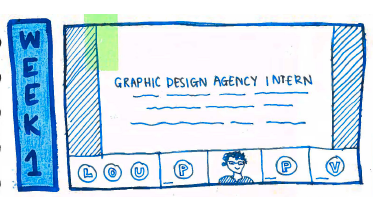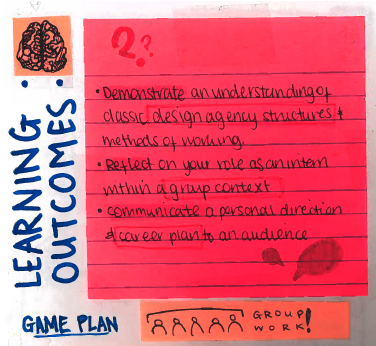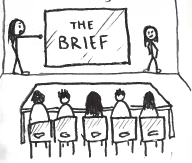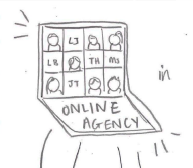
In this post, Zoe Patterson explains how the Design Agency project for Graphic Design students not only survived the pandemic, but was enhanced in its move to an online format. Zoe is Graphic Design Programme Director at Edinburgh College of Art. This post is part of the January and February Learning & Teaching Enhancement Theme: Online/hybrid enhancements in teaching practice.
Annually, undergraduate students on the Graphic Design Programme at Edinburgh College of Art form design agencies that operate as profit-generating companies. The challenge here was to think how this essentially in-person activity could be transformed to an online space for four different year group levels and the many contributors to the course. The Design Agency is all about the reality of the world of work so we needed to echo what was happening externally within the design industry.
Parallels with industry were plentiful, which allowed us to continue to promote the Design Agency scheme at Open Days as producing graduates who are 100% employable. For example, students from all undergraduate levels, along with their voluntary industry mentors, have worked together remotely on TEAMS since March 2020. We found that junior students ‘stepped up’ and, instead of hiding behind their more senior peers, took on the responsibility of engaging with clients and industry professionals.

A recent discussion with an Edinburgh-based creative director reinforced this way of working. He cited the excitement of having a space where all members of a team – not just the lead creative or account handler – get to participate in client meetings; an insightful and enriching experience for all. So too with students, whereby graduate attributes of networking, delegating, pitching, risk-taking were enhanced by the shared experience. Students also felt liberated to experiment with management roles, responsibilities, and presentation styles.
Jelly, Offline, Pleats and Buck were just some of the agency and subsequent channel names we established within the TEAMS software to give each student group a personal online space to meet. They were joined here by staff, external contributors and mentors throughout each semester. Alongside these design agency channels we also created separate spaces on TEAMS for students within a particular year group to meet and indeed be taught. This helped simplify and compartmentalise our communications. The set-up and management of the initial stages of this approach were complex and time-consuming, ensuring all students were added as members of the correct spaces, but, once done, was straightforward to manage.
Within these online spaces students have found their own inventive ways to engage with fellow students: creative work has been digitally posted – pass-the-parcel style – to the next student to add their contribution and so on; design treats have been left at each others physical doorsteps; each student has taken a turn as a facilitator; all the while allowing students to showcase their skills in decision-making, directing, communication and motivation, which are part of the assessed learning objectives of the course.

Many students flourished in this ‘protected’ digital arena, which has acted as a safe space to express their opinions and enthusiasm at having to take an unexpected approach. A number of shy students displayed a newfound confidence in an environment they trusted and felt most comfortable. We saw a re-balancing of group dynamics due to this shift.

Pre-March 2020, we went on site visits to printers and graphic design agencies. More recently ,we have had online presentations and visual walk-throughs. Many sessions have been recorded so, with the appropriate permissions, we can re-use this content if future scheduling is problematic.
The most significant learning for the cohort, though, has been less tangible. Students cite the confidence and reassurance that they now feel about entering the creative industry. Imposter syndrome is a thing of the past when you get to see and hear a normally unreachable design superstar talking from their bedroom in their dressing gown. It’s a real leveller. We have also found that design gurus have been hungry to input into student projects. With more free time and an increased sense of conscience, they have been able to contribute like never before. Distance has also become less of a barrier, with students reaching out for mentors from across the globe.

This academic year, student numbers have now increased on my courses by 30-50%. Without the online space we now inhabit we would not be able to take part in many essential activities and ‘visits’. Now, despite being physically back in the studio, we are continuing to explore online space – just like our industry counterparts.


